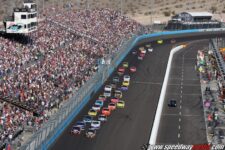
By Dr. Justin Isaacs
It’s the last race of the season at Homestead. Hotels, restaurants, and the rest of Miami is ready for the coming armada of RVs, campers and cars loaded with brightly colored fans flying flags of their favorite drivers. For the better part of the 1990s, and into the early 2000s, NASCAR was the fastest-growing sport in North America. In 2005, NASCAR attendance and TV viewership were at record highs, and through 2007 it maintained a level success organizers only dreamed of a decade earlier—success that many local economies had come to depend on.
All this changed, however, in late 2007. As Americans watched the employees of Lehman Brothers leaving New York offices laden with boxes and the nightly news continually reported on another set of layoffs, NASCAR fans and the businesses they support started to see empty seats. By 2009 NASCAR saw its attendant shrink by 12 percent as race fans, along with the rest of America, faced the growing uncertainty of the faltering economy. Now Americans are faced with a looming “fiscal cliff,” a combination of tax hikes and spending cuts that the Congressional Budget Office estimates would send national unemployment back up to 9.1 percent and plunge America back into a recession.
The financial crisis that started in the fall of 2007 triggered one of the deepest recessions since the Great Depression and left race fans and the rest of America facing the uncertainty and change in expectations that comes with rising unemployment, high gas prices, and a lack of confidence in the future. The recession that started in December 2007 and ended in June 2009, as measured by National Bureau of Economic Research, saw a significant decrease in economic output, a reduction in consumer spending, a significant rise in unemployment, and a significant change in people’s expectations about the future.
As with all recessions, however, there is an eventual recovery. In the past, the magnitude of the recovery is often proportional to the size of the recession: the greater the downturn, the more robust the recovery. This time has been much different. Unlike the historical evidence, this rebound has been slow and anemic. Unresolved issues like the sun-setting of the Bush tax cuts, uncertainty about health care reform, rising national debt, general political partisanship, and the looming fiscal cliff have made it difficult for individuals to shape their expectations and left consumer confidence at extremely low levels. Over the last five quarters economic growth was a mere 2.3 percent, well below our 30-year average and well below the average growth rate in a period following a recession. Perhaps, more importantly, over the last six months job growth has stalled, with employment staying in the range of 8 percent.
NASCAR fans provide a unique barometer for the state of the U.S. economy and the current impact of a slow economic recovery. Unlike the other major sports, NASCAR does not have a “local” team with a prescribed number of home games. The NASCAR season is comprised of 36 races between February and November, but every track hosts only one or two races a year. Because of this feature, NASCAR fans often decide long in advance whether to attend an event, how far they will travel, and how long they will stay. Further, many NASCAR fans spend months saving money for a weekend that can cost upwards of $1,200-$1,500. The financial and time commitment required by fans to attend a NASCAR weekend highlights the most detrimental characteristics of the current economic recovery.
While NASCAR fans are often considered some of the most loyal (or at least most dedicated) of all U.S. sports fans, willing to travel hundreds of miles to spend multiple days celebrating all aspects of a sport they love, the data also suggests that NASCAR fans, much like the economic recovery of the past three years, have been slow to return, with declines continuing through the 2010 season and finally leveling off in the 2011 season. Since the start of the 2006 race season, NASCAR has lost an average of 592 fans a month. More importantly for NASCAR fans are the direct impacts of the sustained levels of unemployment and gas prices that have been slow to recover over the past three years. A reduction in the unemployment rate of just 1 percent would increase the average monthly attendance by approximately 4,000 fans. A reduction of a dollar in gas prices would bring about an average monthly increase of roughly 5,200 fans.
Unfortunately for fans of NASCAR, the anemic recovery of the U.S. economy has not yielded reductions in these measures, and, in the end, it has cost them the ability to enjoy to its fullest the sport that they love so much. Like an unsponsored driver who starts a race only to drive a few laps for fear of a catastrophic accident, NASCAR fans and the rest of America will cautiously wait while policymakers resolve the latent uncertainty in our current economic recovery and try to avert diving off the fiscal cliff. Let us hope that we don’t stall out and have to watch other nations pass us by.
Justin Isaacs is an associate professor of economics, chair of the Economics and Business Department, and Director of the BB&T Entrepreneurship Program at the Center for Entrepreneurship and Political Economy at Hampden-Sydney College.
Click here to see the full study, Racing for Greatness: http://









